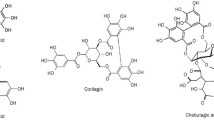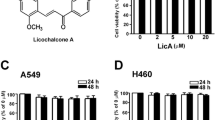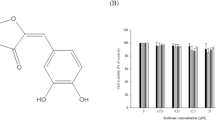Abstract
Metastasis remains the leading cause of death from lung carcinoma. It is urgent to find safe and efficient pre-metastasis preventive agents for cancer survivors. We isolated a flavonoid glycoside, hexamethoxy flavanone-o-[rhamnopyranosyl-(1 → 4)-rhamnopyranoside (HMFRR), from the traditional Chinese medicine (TCM) Murraya paniculata (L.) that can effectively inhibit the adhesion, migration, and invasion of lung adenocarcinoma A549 cells in vitro. Molecular and cellular studies demonstrated that HMFRR significantly downregulated the expressions of cell adhesion-related and invasion-related molecules such as integrin β1, EGFR, COX-2, MMP-2, and MMP-9 proteins. Additionally, HMFRR effectively downregulated the expressions of epithelial–mesenchymal transition (EMT) markers (N-cadherin and vimentin) and upregulated that of E-cadherin. Moreover, these inhibitions were mediated by interrupting STAT3/NF-κB/COX-2 and EGFR/PI3K/AKT signaling pathways. Furthermore, HMFRR counteracted the expressions of cell adhesion molecules (ICAM-1, VCAM-1, and E-selectin) stimulated by interleukin-1β in human pulmonary microvascular endothelial cells (HPMECs). As a result, HMFRR interrupted the adhesion of A549 cells to HPMECs. Collectively, these results indicate that HMFRR may become a good candidate for cancer metastatic chemopreventive agents by interrupting the STAT3/NF-κB/COX-2 and EGFR signaling pathways.






Similar content being viewed by others
References
Siegel RL, Miller KD, Jemal A. Cancer statistics, 2015. CA Cancer J Clin. 2015;65(1):5–29. https://doi.org/10.3322/caac.21254.
Chen W, Zheng R, Baade PD, Zhang S, Zeng H, Bray F, et al. Cancer statistics in China, 2015. CA Cancer J Clin. 2016;66(2):115–32. https://doi.org/10.3322/caac.21338.
Ernani V, Steuer CE, Jahanzeb M. The end of nihilism: systemic therapy of advanced non-small cell lung cancer. Annu Rev Med. 2016; https://doi.org/10.1146/annurev-med-042915-102442.
Lu Y, Yu T, Liang H, Wang J, Xie J, Shao J, et al. Nitric oxide inhibits hetero-adhesion of cancer cells to endothelial cells: restraining circulating tumor cells from initiating metastatic cascade. Sci Rep. 2014;4:4344. https://doi.org/10.1038/srep04344.
Xie J, Lu Y, Dong H, Zhao R, Chen H, Shen W, et al. Enhanced specificity in capturing and restraining circulating tumor cells with dual antibody-dendrimer conjugates. Adv Funct Mater. 2015;25(8):1304–13. https://doi.org/10.1002/adfm.201403556.
Wan L, Dong H, Xu H, Ma J, Zhu Y, Lu Y, et al. Aspirin, lysine, mifepristone and doxycycline combined can effectively and safely prevent and treat cancer metastasis: prevent seeds from gemmating on soil. Oncotarget. 2015;6(34):35157–72. 10.18632/oncotarget.6038.
Ribelles N, Santonja A, Pajares B, Llacer C, Alba E. The seed and soil hypothesis revisited: current state of knowledge of inherited genes on prognosis in breast cancer. Cancer Treat Rev. 2014;40(2):293–9. https://doi.org/10.1016/j.ctrv.2013.09.010.
Quail DF, Joyce JA. Microenvironmental regulation of tumor progression and metastasis. Nat Med. 2013;19(11):1423–37. https://doi.org/10.1038/nm.3394.
Lian S, Lu Y, Cheng Y, Yu T, Xie X, Liang H, et al. S-nitrosocaptopril interrupts adhesion of cancer cells to vascular endothelium by suppressing cell adhesion molecules via inhibition of the NF-small ka, CyrillicB and JAK/STAT signal pathways in endothelial cells. Eur J Pharmacol. 2016;791:62–71. https://doi.org/10.1016/j.ejphar.2016.08.018.
Talmadge JE, Fidler IJ. AACR centennial series: the biology of cancer metastasis: historical perspective. Cancer Res. 2010;70(14):5649–69. https://doi.org/10.1158/0008-5472.can-10-1040.
Gkountela S, Aceto N. Stem-like features of cancer cells on their way to metastasis. Biol Direct. 2016;11:33. https://doi.org/10.1186/s13062-016-0135-4.
Leong SPL, Tseng WW. Micrometastatic cancer cells in lymph nodes, bone marrow, and blood: clinical significance and biologic implications. CA Cancer J Clin. 2014;64(3):195–206. https://doi.org/10.3322/caac.21217.
Seretis F, Seretis C, Youssef H, Chapman M. Colorectal cancer: seed and soil hypothesis revisited. Anticancer Res. 2014;34(5):2087–94.
Chaffer CL, San Juan BP, Lim E, Weinberg RA. EMT, cell plasticity and metastasis. Cancer Metastasis Rev. 2016;35:645–54.
Taube JH, Herschkowitz JI, Komurov K, Zhou AY, Gupta S, Yang J, et al. Core epithelial-to-mesenchymal transition interactome gene-expression signature is associated with claudin-low and metaplastic breast cancer subtypes. Proc Natl Acad Sci U S A. 2010;107(35):15449–54. https://doi.org/10.1073/pnas.1004900107.
Mitra A, Mishra L, Li S. EMT, CTCs and CSCs in tumor relapse and drug-resistance. Oncotarget. 2015;6(13):10697–711.
Wik E, Raeder MB, Krakstad C, Trovik J, Birkeland E, Hoivik EA, et al. Lack of estrogen receptor-alpha is associated with epithelial-mesenchymal transition and PI3K alterations in endometrial carcinoma. Clin Cancer Res: Off J Am Assoc Cancer Res. 2013;19(5):1094–105. https://doi.org/10.1158/1078-0432.CCR-12-3039.
Qin G, Xu F, Qin T, Zheng Q, Shi D, Xia W, et al. Palbociclib inhibits epithelial-mesenchymal transition and metastasis in breast cancer via c-Jun/COX-2 signaling pathway. Oncotarget. 2015;6(39):41794–808.
Ravi J, Elbaz M, Wani NA, Nasser MW, Ganju RK. Cannabinoid receptor-2 agonist inhibits macrophage induced EMT in non-small cell lung cancer by downregulation of EGFR pathway. Mol Carcinog. 2016;55(12):2063–76. https://doi.org/10.1002/mc.22451.
Li W, Yue W, Wang H, Lai B, Yang X, Zhang C, et al. Cyclooxygenase-2 is associated with malignant phenotypes in human lung cancer. Oncol Lett. 2016;12(5):3836–44. https://doi.org/10.3892/ol.2016.5207.
Bocca C, Ievolella M, Autelli R, Motta M, Mosso L, Torchio B, et al. Expression of Cox-2 in human breast cancer cells as a critical determinant of epithelial-to-mesenchymal transition and invasiveness. Expert Opin Ther Targets. 2014;18(2):121–35. https://doi.org/10.1517/14728222.2014.860447.
Bollrath J, Greten FR. IKK/NF-kappaB and STAT3 pathways: central signalling hubs in inflammation-mediated tumour promotion and metastasis. EMBO Rep. 2009;10(12):1314–9. https://doi.org/10.1038/embor.2009.243.
Gong J, Xie J, Bedolla R, Rivas P, Chakravarthy D, Freeman JW, et al. Combined targeting of STAT3/NF-kappaB/COX-2/EP4 for effective management of pancreatic cancer. Clin Cancer Res: Off J Am Assoc Cancer Res. 2014;20(5):1259–73. https://doi.org/10.1158/1078-0432.CCR-13-1664.
Saied S, Nizami SS, Anis I. Two new coumarins from Murrayapaniculata. J Asian Nat Prod Res. 2008;10(6):515–9. https://doi.org/10.1080/10286020801967292.
Rodanant P, Khetkam P, Suksamrarn A, Kuvatanasuchati J. Coumarins and flavonoid from Murrayapaniculata (L.) Jack: antibacterial and anti-inflammation activity. Pak J Pharm Sci. 2015;28(6):1947–51.
Wang NG, Guan MZ, Lei HP. Studies on anti-implantation and hormone activity of yuehchukene, an alkaloid isolated from the root of Murrayapaniculata. Yao xuexuebao = ActapharmaceuticaSinica. 1990;25(2):85–9.
Nguyen Manh C, Pham Ngoc K, Ho Viet D, Tran Thu H, Bui Huu T, Nguyen Quoc B, et al. Vasorelaxing activity of two coumarins from Murrayapaniculata leaves. Biol Pharm Bull. 2014;37(4):694–7.
Chen KS, Wu CC, Chang FR, Chia YC, Chiang MY, Wang WY, et al. Bioactive coumarins from the leaves of Murrayaomphalocarpa. Planta Med. 2003;69(7):654–7.
Wu J, Liu K, Shi X. The anti-inflammatory activity of several flavonoids isolated from Murrayapaniculata on murine macrophage cell line and gastric epithelial cell (GES-1). Pharm Biol. 2016;54(5):868–81.
Kong YC, Ng KH, Wat KH, Wong A, Saxena IF, Cheng KF, et al. Yuehchukene, a novel anti-implantation indole alkaloid from Murrayapaniculata. Planta Med. 1985;51(4):304–7.
Jiang Z, Pang Y, Yu X, Zhou S, Qian J, Zheng N, et al. The paradigm-shifting idea and its practice: from traditional abortion Chinese medicine Murrayapaniculata to safe and effective cancer metastatic chemopreventives. Oncotarget. 2016;7(16):21699–712. https://doi.org/10.18632/oncotarget.7932.
Shao J, Zhou S, Jiang Z, Chi T, Ma J, Kuo M, et al. Warfarin and coumarin-like Murrayapaniculata extract down-regulate EpCAM-mediated cell adhesion: individual components versus mixture for studying botanical metastatic chemopreventives. Sci Rep. 2016;6:30549. https://doi.org/10.1038/srep30549.
Meng F, Wu G. The rejuvenated scenario of epithelial-mesenchymal transition (EMT) and cancer metastasis. Cancer Metastasis Rev. 2012;31(3–4):455–67. https://doi.org/10.1007/s10555-012-9379-3.
Yoon J, Cho SJ, Ko YS, Park J, Shin DH, Hwang IC, et al. A synergistic interaction between transcription factors nuclear factor-κB and signal transducers and activators of transcription 3 promotes gastric cancer cell migration and invasion. BMC Gastroenterol. 2013;13:29. https://doi.org/10.1186/1471-230X-13-29.
Nijveldt RJ, van Nood E, van Hoorn DEC, Boelens PG, van Norren K, van Leeuwen PAM. Flavonoids: a review of probable mechanisms of action and potential applications. Am J Clin Nutr. 2001;74(4):418–25.
Bhat FA, Sharmila G, Balakrishnan S, Arunkumar R, Elumalai P, Suganya S, et al. Quercetin reverses EGF-induced epithelial to mesenchymal transition and invasiveness in prostate cancer (PC-3) cell line via EGFR/PI3K/Akt pathway. J Nutr Biochem. 2014;25(11):1132–9. https://doi.org/10.1016/j.jnutbio.2014.06.008.
Chien SY, Hsieh MJ, Chen CJ, Yang SF, Chen MK. Nobiletin inhibits invasion and migration of human nasopharyngeal carcinoma cell lines by involving ERK1/2 and transcriptional inhibition of MMP-2. Expert OpinTher Targets. 2015;19(3):307–20. https://doi.org/10.1517/14728222.2014.992875.
van Zijl F, Krupitza G, Mikulits W. Initial steps of metastasis: cell invasion and endothelial transmigration. Mutat Res Rev Mutat Res. 2011;728(1–2):23–34. https://doi.org/10.1016/j.mrrev.2011.05.002.
Meager A. Cytokine regulation of cellular adhesion molecule expression in inflammation. Cytokine Growth Factor Rev. 1999;10(1):27–39. https://doi.org/10.1016/s1359-6101(98)00024-0.
Luscinskas FW, Gimbrone MA. Endothelial-dependent mechanisms in chronic inflammatory leukocyte recruitment. Annu Rev Med. 1996;47:413–21.
Unger RE, Krump-Konvalinkova V, Peters K, Kirkpatrick CJ. In vitro expression of the endothelial phenotype: comparative study of primary isolated cells and cell lines, including the novel cell line HPMEC-ST1.6R. Microvasc Res. 2002;64(3):384–97. https://doi.org/10.1006/mvre.2002.2434.
Dufour A, Sampson NS, Zucker S, Cao J. Role of the hemopexin domain of matrix metalloproteinases in cell migration. J Cell Physiol. 2008;217(3):643–51. https://doi.org/10.1002/jcp.21535.
Kurzepa J, El-Demerdash FM, Castellazzi M. Matrix metallo proteinases as a pleiotropic biomarker in medicine and biology. Dis Markers. 2016; https://doi.org/10.1155/2016/9275204.
Tang Q, Liu Y, Li T, Yang X, Zheng G, Chen H, et al. A novel co-drug of aspirin and ursolic acid interrupts adhesion, invasion and migration of cancer cells to vascular endothelium via regulating EMT and EGFR-mediated signaling pathways: multiple targets for cancer metastasis prevention and treatment. Oncotarget. 2016;7(45):73114–29. https://doi.org/10.18632/oncotarget.12232.
Zavadil J, Cermak L, Soto-Nieves N, Bottinger EP. Integration of TGF-beta/Smad and Jagged1/Notch signalling in epithelial-to-mesenchymal transition. EMBO J. 2004;23(5):1155–65. https://doi.org/10.1038/sj.emboj.7600069.
Neil JR, Johnson KM, Nemenoff RA, Schiemann WP. Cox-2 inactivates Smad signaling and enhances EMT stimulated by TGF-beta through a PGE(2)-dependent mechanisms. Carcinogenesis. 2008;29(11):2227–35. https://doi.org/10.1093/carcin/bgn202.
Lee H, Herrmann A, Deng J-H, Kujawski M, Niu G, Li Z, et al. Persistently activated Stat3 maintains constitutive NF-kappa B activity in tumors. Cancer Cell. 2009;15(4):283–93. https://doi.org/10.1016/j.ccr.2009.02.015.
Birsu Cincin Z, Unlu M, Kiran B, Sinem Bireller E, Baran Y, Cakmakoglu B. Anti-proliferative, apoptotic and signal transduction effects of hesperidin in non-small cell lung cancer cells. Cell Oncol. 2015;38(3):195–204. https://doi.org/10.1007/s13402-015-0222-z.
Acknowledgements
This research was supported by grants from National Natural Science Foundation of China (U1505225), Ministry of Science and Technology of China (MOST 2015CB931804) and Fujian Development and Reform Commission project no. 829054 (2014/168), and Education Ministry of Fujian Province of China (JA15057)
Author information
Authors and Affiliations
Corresponding author
Rights and permissions
About this article
Cite this article
Shi, Q., Jiang, Z., Yang, J. et al. A Flavonoid Glycoside Compound from Murraya paniculata (L.) Interrupts Metastatic Characteristics of A549 Cells by Regulating STAT3/NF-κB/COX-2 and EGFR Signaling Pathways. AAPS J 19, 1779–1790 (2017). https://doi.org/10.1208/s12248-017-0134-0
Received:
Accepted:
Published:
Issue Date:
DOI: https://doi.org/10.1208/s12248-017-0134-0




